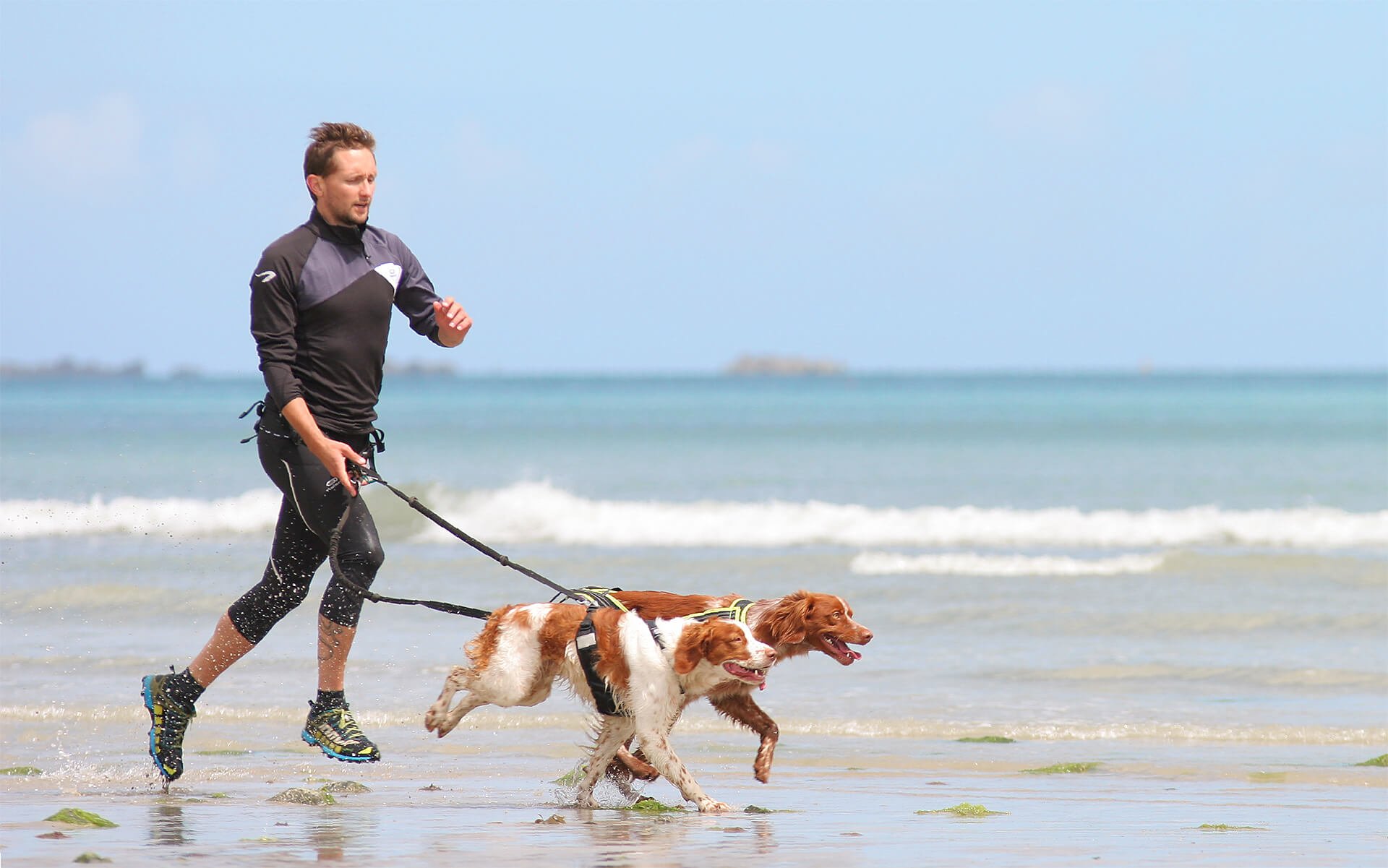
Start canicross with your dog
How to do canicross with your dog? What advice to start canicross? What equipment to use for canicross? All the answers to your questions in this article!
Table of contents
As you may already know, Musher and I practice the canicross and even the canitrail. Do you want to get into it too? Exercising with your dog, It's awesome.
When I started this sport with my dog, I made a lot of mistakes. So when we run together, I don't feel she's super motivated. She does it for me and I don't like it. I would like her to have fun and ask for more… so after having had the chance to meet David from the Canicross-experience blog, we started all over again to gradually relearn the pleasures of running. This is an opportunity for me to share his precious advice with you if you want to embark on this activity with your dog.
David from Canicross-Experience
Before anything else, let me introduce you to David. He is a former professional sportsman who played football for 16 years. When he adopted Ice, his Breton spaniel 4 years old, he looked for an activity that allows his dog to spend all his energy intelligently. Quite naturally, they started canicross together. At that time, it was a very confidential sport and there was very little advice online on how to start correctly. David interviewed professional mushers, veterinarians and top athletes to understand their physical preparation and that of their dogs. When you do canicross, you also run! Even if your dog helps you a little, you have to succeed in following behind…. so both of you need good physical preparation even if you don't practice this sport at a high level.
Canicross equipment, the key to success
Let's get back to the heart of the subject that interests us today: start canicross with your dog. The first mistake not to make is that of leaving without the appropriate equipment. Above all, to take pleasure in running, you must be well equipped and this is valid for you as well as for your dog. Running in sandals is out of the question: do we agree? It's the same for his dog; we don't make him run or tow with his riding harness or worse his collar. It will need to be fitted with a specific harness connected to you by an elastic lanyard attached to your own harness or belt. If you want to know more about the material to use, I advise you to read or re-read the article Canicross – running with the right equipment.
A quick reminder of the essential equipment for your dog:
A harness for the dog. For my part, I have tested several, I tell you about them in the Top 10 dog traction harnesses. THE Omnijore Harness from Ruffwear is the one we totally embraced Musher and me!
A elastic lanyard short or long. The choice of length depends on the terrain and your running style. For my part, Musher is more reactive in short lanyard but it requires me to be super vigilant to anticipate each step, not to miss a stone and risk falling.
A harness or canicross belt for you. For my part, I tested 2: the harness Whip and Canyon I-Dog. Two different gears and two different sensations that I will detail for you here. It's up to you to find your style for a successful canicross session!
![]() The opinion of Musher and Sophie: - “Our comparison identifies the Top 10 Best Dog Traction Harnesses ! You will find the equipment best suited to your practice and to the size of your dog of course!”
The opinion of Musher and Sophie: - “Our comparison identifies the Top 10 Best Dog Traction Harnesses ! You will find the equipment best suited to your practice and to the size of your dog of course!”
You can learn to tow
The second mistake to avoid is to go head-on with your dog and imagine that he will start running naturally in front of you and tow you for 10kms! The key word in learning is progression! If your dog has never run before, you will have to give him a taste for sport and not disgust him as soon as he first workout.
I'm well placed to know because I made this big mistake! I used to run before adopting Musher, when she was old enough to start training, I put her in the harness and shoo… Except that well, it didn't go as I dreamed. Musher did not understand the principle of canicross and traction. During training, she gets in front of me but as soon as she feels a pull, she slows down to exactly match my pace. And I have to motivate her a lot throughout the course. For her, when I take the harness out it's the punishment… What a failure!
So I signed up for canicross so she could see the other dogs doing it and I even made my husband run in front with candy in his hand but nothing happened. That's why I've been starting all over again for a few days with a progressive program of several weeks (right David?!).
I would like Musher to enjoy running with me. With patience and love, I will try to make him rediscover this great sport.
Finally, to be more fair, Musher likes to run when we are in a group. I belong to a club between and she comes with me in training. She is the only dog. There are about ten of us and she really likes the group atmosphere because during these sessions she tows around a bit and really has a blast… I would like her to also have this desire when we only run together!
(I secretly envy the masters with dogs that jump 3m in front of the starting line so excited that they are given the starting go… and that they run like mad with enthusiasm).

Warm up!
The third mistake to avoid is to leave immediately and not warmed up either. Before you start your session, warm up. Let your dog walk around for a few minutes, while he sniffs some good smells to find his playground and do his business. Once harnessed he will be relaxed and ready to race, more focused on what is expected of him. On this subject, just like for classic walks, it is super important to vary the routes; otherwise your dog will quickly get bored (like you) and get bored.
The first weeks of training
Remember the key word “progressivity”!
Start with your dog running loose. After a while, put on your gear and get going again. Quite naturally, your dog will stand in front of you. Pick up the pace without running; he too should accelerate to keep his place as leader. Praise him when there's a slight tug so he understands what you expect of him. Some dogs instinctively tow for others it is a job that must be learned (this is the case of Musher). After 5 minutes, stop training, congratulate him warmly and undo the equipment. Don't leave it to him, so he will associate the harness with this sport.
For a few days, repeat the exercise a stroll on two by increasing the duration a little bit to reach 10 minutes of brisk walking. Try to do these sessions on descents, it will make the session even easier because your dog will get into traction even more naturally.
Like you, if your dog has never run or towed, he needs to learn and build a little muscle. These discovery sessions will help you improve your performance little by little. Do not force, do things with progression. This is the key for your dog like you to enjoy running together.
After a week, you can start to slightly increase the pace and distance. Slightly huh! If your dog is not comfortable during the effort, you will disgust him and he may stop moving forward altogether or refuse the pull (that's what he's passed for Musher)! You have to learn to run together and discover your limits together. You form a team with your dog, so you have to respect everyone's needs. It is essential never to exceed your dog's limit during this learning phase and to always stop training quickly. It will frustrate your dog who will ask for more and more next time!
It is only after 2 weeks, after these small sessions that David advises to engage the race mode. Again, you have to start on small distances like 1km and then gradually increase. Your dog must have fun over short distances to push the pleasure further. It is essential to understand! Especially when you have a dog that does not immediately understand what is expected of him. Canicross is an activity at the service of well-being to enjoy sports! It is a beautiful activity to do with your dog.
Right, left, stop… orders to master
To having fun with your dog and in complete safety, he will have to master a few basic commands such as right, left, stop, slow down or behind. Musher runs behind me on a cani-trail when the slope is too steep for me to follow… it avoids falls. Uphill: zero traction. But downhill, she puts the naughty full throttle! To learn these commands easily, do it on a walk. When you take a path to the right, say “right”. When you stop say “stop”. He will associate the words with what is happening. Praise him when he responds correctly to the command. He should quickly understand!
Given David's advice, I am now certain that my training plans were all rotten. If Musher doesn't tow uphill, she can't because we don't have the necessary training. Doing canitrail is even more demanding because the effort is sometimes super intense over a short period of time. Whereas in canicross the rhythm is quite regular: it is rather fast over short distances (5-7km). So here we go, we erase and we start all over again with Musher!
Vary the workouts
Depending on your goals, shopping, hobbies, canitrail, weight loss (your dog or you), taking a breath of fresh air, your workouts will be different and their pace too. So prepare your sessions in advance to vary the pleasures and increase your performance. Know that there is no small performance! Sometimes, in training, I meet trail runners who tell me “ugh, too easy eh! running with a dog is cheating!”…. But LOL what!! Forming a team with your dog: it's knowing how to read your dog by observing its ears and its tail during the effort (has it sniffed out a track, is there a danger in front of us?….), know how to direct it to avoid ending up in the background, anticipate obstacles (if your dog accelerates right when you pass a puddle, there is a good chance that you will put your foot in it! hihi), follow its pace... it's not easy!! And finding the right balance to form one with your dog is also quite an art! It requires a strong bond.
Remember to always space out the sessions enough so that your dog has time to recover and you too. And according to your objectives, prepare your sessions. In order not to get bored and your dog does not have more, vary the pleasures: 2km run / 2km in free market or 500m very fast / 2km normal race or sequences of several slopes with free descent / …. in short, the variation of the sessions is limited to your imagination!
Confidence for confidence
I have a secret to tell you, if you are not used to running, the first training sessions will be quite painful but after a while, you are more comfortable and the pleasure is there. Promised! With that, I'm going to put on my sneakers and with Musher we continue our mini-sessions to relearn the pleasure of running together. In a few weeks, I will give you news of the evolution of Musher.
I take advantage of this final word to give you two last tips: do not feed your dog 2 hours before or after training to avoid stomach upsets. And the same for water, it is better to serve it to him in small doses after the effort.
I am very grateful to David for all his valuable advice. His own philosophy “canicross is a marvelous tool at the service of pleasure, well-being and complicity with your dog!”. Holder of the Federal animator's certificate passed with the Federation of Canine Sports and Leisure, he taught me a lot of things about cani-cross. Finally, if I had to remember one thing it is that for the master as for the dog, cani-cross can be learned. There are dogs that naturally will quickly understand pulling and have a blast and others for whom this sport will not be suitable. After all, we humans absolutely don't all like to play sports and run… it's the same for dogs, everyone has their own desires!
✅ Thousands of dog-friendly addresses are waiting for you: start a search and go on vacation with your dog! ✅
organize your holidays
 Read also
Read also
- Céline and her pack: our Dog-Reporters fans of canicross
- Cycling with your dog: advice and equipment
- Hiking with your dog cannot be improvised
Traveling with a dog
Book accommodation
Book among the QUALIDOG-labeled accommodation for your holidays
Search for a hotel or accommodation “ok dog” on Booking
- 🛖 Find unusual dog-friendly accommodation on Abracadaroom
- (I.e. Find an “ok dog” campsite for this stay
(By booking your tickets and stays via these links, you will be supporting the site since we will receive a small, very useful commission to finance the many pending projects!)


